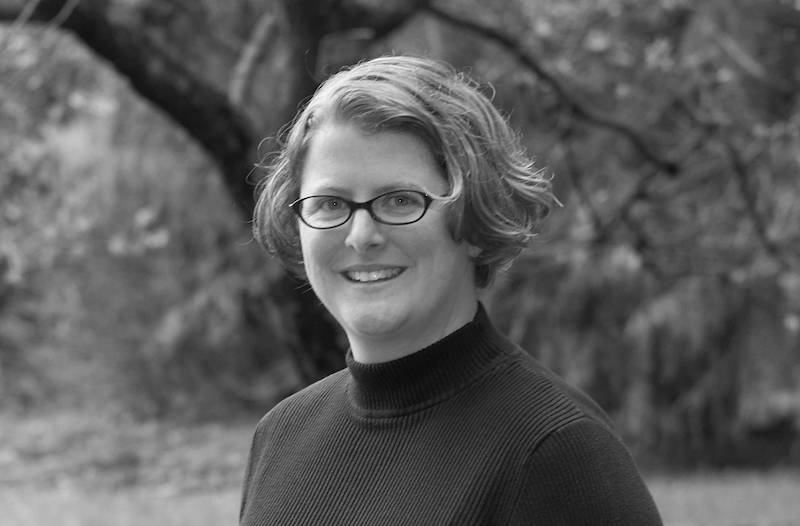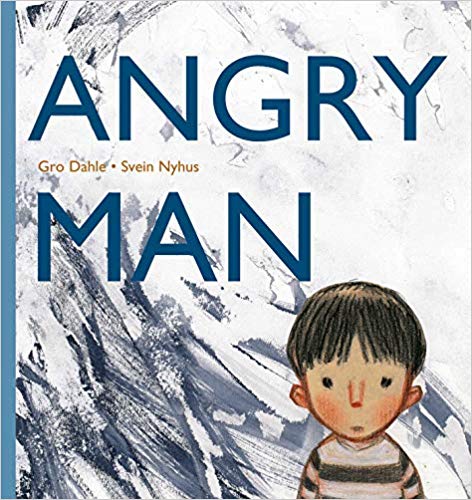By Heather Lennon, NorthSouth Books, with Hannah Gill, University of Arizona, Tucson
 Tara Chace, a translator living in Seattle, has translated Norwegian, Danish and Swedish books into U.S. English since 1999. Angryman by Gro Dahle immediately draws a reader in because of its heavy use of imagery that captures the fear and sadness of the main character, Boj. The book tackles a heavy subject in a meaningful and important way. NorthSouth Books’ recent Q&A with Tara Chace can give readers a context to the work’s subject as well as an understanding of translating picturebooks more generally. In that interview (adapted here), Chace discusses the book and her career with translating, as well as Nordic books and the heavy subject matter that Angryman features.
Tara Chace, a translator living in Seattle, has translated Norwegian, Danish and Swedish books into U.S. English since 1999. Angryman by Gro Dahle immediately draws a reader in because of its heavy use of imagery that captures the fear and sadness of the main character, Boj. The book tackles a heavy subject in a meaningful and important way. NorthSouth Books’ recent Q&A with Tara Chace can give readers a context to the work’s subject as well as an understanding of translating picturebooks more generally. In that interview (adapted here), Chace discusses the book and her career with translating, as well as Nordic books and the heavy subject matter that Angryman features.
Becoming a translator
During her junior year abroad in college, Chace went to Bergen, Norway to study Scandinavian language and literature. Chace explains that she went on to earn her master’s and doctorate in Scandinavian literature as well. When she was getting her Ph.D., someone offered her an opportunity to translate an article on a sailor so she could earn some extra money. She enjoyed doing this, and while she continued her formal education, Chace said yes to translating opportunities on the side. Ultimately, Chace decided to pursue a job in translating rather than become a professor of Scandinavian literature. She loves contemporary literature, and translation gives her the opportunity to work with more recent literature.
Chase explains that since then, it “all worked out like a dream.” Later she says, “every day when I go to work, I feel like I’m doing my part to promote global understanding.” Now, Chace translates Scandinavian books into U.S. English full time, and she enjoys reading her early translations to her two children. Some of Chace’s translations include Invisible Murder by Lene Kaaberbøl and Angnete Friis, The Doctor Proctor Series by Jo Nesbø, and You & You & You by Per Nilsson, which was the winner of the LA Times book award.
Angryman, its subject matter and illustrations
Drawing a reader in and continuing to affect them while reading Angryman, is the heavy subject and breathtaking illustrations. The illustrations add a deeper layer to the text, and because of this, readers may be more impacted and affected by this story and the message. The pictures alone convey the full weight of the emotions and the impact that Boj’s dad has on him.
Chace explains that she knows the illustrator of the book. While he normally illustrates more lighthearted and funny books, she knows that “he and Gro Dahle have continued to push the boundaries of what readers commonly find in picture books with more serious topics.” Even so, the book still took her breath away.
However, the subject matter of the book did not surprise Tara Chace in the same way that it might surprise others (especially American readers). Often books written by Nordic authors contain a sensibility and willingness to tackle difficult conversations artistically yet matter-of-factly. In this way, Angryman is similar to other books that Chace has translated, such as I Need You More Than I Love You and I Love You to Bits by Gunnar Ardelius, which tackles the issue of bipolar disorder as well as first love. She continues by saying that, “in general, Scandinavian children’s books don’t shy away from topics that Americans often find difficult to acknowledge bluntly in the context of children’s literature.”
On translating texts and picturebooks
 A tricky aspect of translating is deciding when to change aspects of a book and when to translate more literally. Chace explains that when it is a good author, as Gro Dahle is, the less she wants to alter the text. However, at points throughout a book, some portions or descriptions may change to keep the overall meaning and feel of the text the same. For example, in Angryman, there is one word that translates to mean “apple-cake-happy,” which would have a specific connotation for a Norwegian reading the story. But because an American reading the book would not get this same feeling, Chace decided to write “cheerful as apple pie” instead. In this case, Chace “‘localized’ the apple recipe to evoke the same familiar, warm, homey feeling, but [she] needed different words to get to that feeling.”
A tricky aspect of translating is deciding when to change aspects of a book and when to translate more literally. Chace explains that when it is a good author, as Gro Dahle is, the less she wants to alter the text. However, at points throughout a book, some portions or descriptions may change to keep the overall meaning and feel of the text the same. For example, in Angryman, there is one word that translates to mean “apple-cake-happy,” which would have a specific connotation for a Norwegian reading the story. But because an American reading the book would not get this same feeling, Chace decided to write “cheerful as apple pie” instead. In this case, Chace “‘localized’ the apple recipe to evoke the same familiar, warm, homey feeling, but [she] needed different words to get to that feeling.”
She also gives a similar example with a cake decorated with flag (the specific cake being called a kransekake). But because few American readers would understand this reference, like with the apple pie example, she took leeway and changed the reference to be a three-layer birthday cake with candles on top. Chace explains that, “as a translator, I want to help the English-speaking reader experience the story the way a Norwegian reader can experience the original, without anything that would be too distracting from the author’s message.”
While some people think that translating children’s literature is easier, it is often more challenging because the translator must think about both the pictures and words. Children’s books combine a variety of features and illustrations to tell the story. It can be hard to get all of the elements to interact and tell the story as intended. Furthermore, Scandinavian books often have more words on the page than American picturebooks generally would. This means that the adult reading the story and the child listening have different experiences with the text. So, “the words and the pictures really have to work together, and the words in the translation really need to ‘see’ the pictures, too,” Chace notes.
The importance of translated books, especially in a classroom setting
NorthSouth Books felt that the translation of Angryman should be sensitive as well as lyrical, and are pleased with Tara’s translation and the rationale behind her textual decisions. The core of NorthSouth’s publishing program consists of books in translation and the company believes in the importance of the translation. NorthSouth feels that children’s literature is in a global moment where readers beyond teachers and librarians are acknowledging the importance of translated children’s books. The publisher’s international authors have long participated in skype visits with schools in America and other countries around the world. Translator school visits are another way of exposing children to multilingualism, the concept of lyrical translation versus the straight word for word. A list of translated titles also yields surprise when children realize that many of their favorites, such as The Rainbow Fish (Marcus Pfister, 1992), The Story of Babar (Jean de Brunhoff, 1931), The Little Prince (Antoine de Saint-Exupéry, 1943) and Pippi Longstocking (Astrid Lindgren, 1945) were created in another language. Many translated titles highlight the differences in our worlds, but more often young readers delight in finding the common ground.
Educators and librarians interested in introducing young people to translation may also be interested in the Stephen Spender Trust’s Translators in Schools. This United Kingdom-based organization raises the profile of translation, multilingualism and language-learning through creative translation workshops in schools; teacher-training, consultancy and public engagement in the field of multilingual creativity; and developing creative translation resources for teachers and translators. Although Translators in Schools is based in the U.K., educators in the U.S. may find ideas and inspiration for practice in their own locations.
Practitioners and researchers looking for an academic resource for the translation of books for young people can start with the work of Gillian Lathey. Also from the U.K, Lathey’s books on translating children’s literature include The Role of Translators in Children’s Literature: Invisible Storytellers – Children’s Literature and Culture andTranslating Children’s Literature – Translation Practices Explained, available from Routledge.
World of Words looks forward to Angryman coming to its collection soon! Learn more about Tara Chace and her work via her blog.
Authors’ Corner is a periodic profile featured on our blog where authors discuss their writing process and the importance of school visits. Worlds of Words frequently hosts these authors for events in the collection. To find out when we are hosting an author, check out our events page. Journey through Worlds of Words during our open reading hours: Monday-Friday, 9 a.m. to 5 p.m. and Saturday, 9 a.m. to 1 p.m.
- Themes: Angryman, Gro Dahle, Hannah Gill, Heather Lennon, Tara Chace
- Descriptors: Authors' Corner

Tara Chase’s translation from Danish to English is not good. Strange americanized phrases keep appearing in her translation of Katrine Engberg’s ‘The Tennant’. So much so, that I am going to stop reading it and order the Danish version. It is obvious that her Danish use of language is insufficient. I am a Dane and proud of it! Katrine – dont use her again!